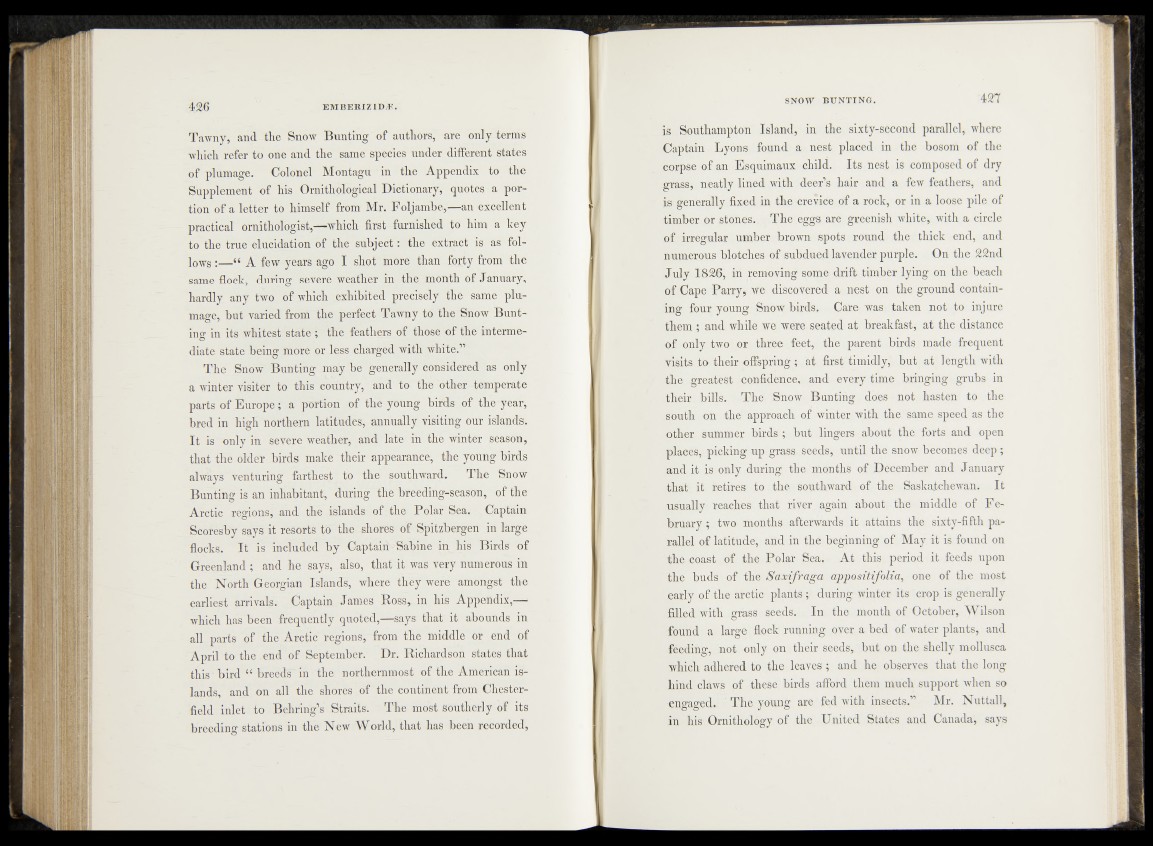
Tawny, and tlie Snow Bunting of authors, are only terms
which refer to one and the same species under different states
of plumage. Colonel Montagu in the Appendix to the
Supplement of his Ornithological Dictionary, quotes a portion
of a letter to himself from Mr. Foljambe,—an excellent
practical ornithologist,—which first furnished to him a hey
to the true elucidation of the subject: the extract is as follows
;—U A few years ago I shot more than forty from the
same flock, during severe weather in the month of January,
hardly any two of which exhibited precisely the same plumage,
but varied from the perfect Tawny to the Snow Bunting
in its whitest state ; the feathers of those of the intermediate
state being more or less charged with white.”
The Snow Bunting may be generally considered as only
a winter visiter to this country, and to the other temperate
parts of Europe; a portion of the young birds of the year,
bred in high northern latitudes, annually visiting our islands.
It is only in severe weather, and late in the winter season,
that the older birds make their appearance, the young birds
always venturing farthest to the southward. The Snow
Bunting is an inhabitant, during the breeding-season, of the
Arctic regions, and the islands of the Polar Sea. Captain
Scoresby says it resorts to the shores of Spitzbergen in large
flocks. It is included by Captain Sabine in his Birds of
Greenland ; and he says, also, that it was very numerous in
the North Georgian Islands, where they were amongst the
earliest arrivals. Captain James Ross, in his Appendix,—
which has been frequently quoted,—says that it abounds in
all parts of the Arctic regions, from the middle or end of
April to the end of September. Dr. Richardson states that
this bird “ breeds in the northernmost of the American islands,
and on all the shores of the continent from Chesterfield
inlet to Behring’s Straits. The most southerly of its
breeding stations in the New World, that has been recorded,
is Southampton Island, in the sixty-second parallel, where
Captain Lyons found a nest placed in the bosom of the
corpse of an Esquimaux child. Its nest is composed of dry
grass, neatly lined with deer’s hair and a few feathers, and
is generally fixed in the crevice of a rock, or in a loose pile of
timber or stones. The eggs are greenish white, with a circle
of irregular umber brown spots round the thick end, and
numerous blotches of subdued lavender purple. On the 22nd
July 1826, in removing some drift timber lying on the beach
of Cape Parry, we discovered a nest on the ground containing
four young Snow birds. Care was taken not to injure
them ; and while we were seated at breakfast, at the distance
of only two or three feet, the parent birds made frequent
visits to their offspring ; at first timidly, but at length with
the greatest confidence, and every time bringing grubs in
their bills. The Snow Bunting does not hasten to the
south on the approach of winter with the same speed as the
other summer birds ; but lingers about the forts and open
places, picking up grass seeds, until the snow becomes deep ;
and it is only during the months of December and January
that it retires to the southward of the Saskatchewan. It
usually reaches that river again about the middle of February
; two months afterwards it attains the sixty-fifth parallel
of latitude, and in the beginning of May it is found on
the coast of the Polar Sea. At this period it feeds upon
the buds of the Saxifraga appositifolia, one of the most
early of the arctic plants ; during winter its crop is generally
filled with grass seeds. In the month of October, Wilson
found a large flock running over a bed of water plants, and
feeding, not only on their seeds, but on the shelly mollusca
which adhered to the leaves ; and he observes that the long
hind claws of these birds afford them much support when so
engaged. The young are fed with insects.” Mr. Nuttall,
in his Ornithology of the United States and Canada, says